
20 minute read
A Great Public Servant
By Lt. Col. Kimberly J. Cox
Command Judge Advocate, 104th Division (Leader Training)
Advertisement
“Ask not what your country can do for you, but what you can do for your country.” – John F. Kennedy
From the center of Texas to the heart of southwest Minnesota farmland and then to the Pacific Northwest-- with detours through Kentucky, Mississippi, Saudi Arabia and Iraq—retiring 104th Division (LT) Deputy Command Judge Advocate Maj. Fred Inman has been, and continues to be, a classic American putting public service before himself throughout his career.
Born in Brownwood, Texas and growing up in Mankato, Minnesota, Maj. Inman early on set out for a career in public service. When he graduated from high school in 1978, Maj. Inman started college while driving an ambulance to pay his way. From 1978 until 1996, Maj. Inman earned and maintained his qualifications as an Emergency Medical Technician (EMT). However, while driving an ambulance, he quickly saw that law enforcement officers seemed to get to the scenes faster and their jobs appeared more exciting. Maj. Inman quickly changed up his educational goals: he left his university studies to enroll in Alexandria Technical Institute in Minnesota, obtaining his two-year law enforcement associate’s degree. From 1983 until 1990, Maj. Inman worked for several small town police departments in Minnesota.
One of his favorite memories from those years was a call where he responded to back up a state trooper on a drunk driving call: there was snow on the ground and the driver had driven off the road, losing the vehicle’s drive train in the process. When the trooper walked up to the car, he knocked on the driver’s window. The driver
Maj. Inman and his wife Teresa kayaking.
looked up at the officers with a shocked expression. Moments later, the driver’s expression switched to something more determined, pressing the accelerator, ignoring the officers. The driver, intoxicated to the degree that he believed the car was actually moving, turned to laugh with his passenger and then turned to look back out the driver’s side window-- only to see the trooper “running” alongside the car. The trooper continued to move his feet like he was running while the drunk driver pressed the accelerator harder. In return, the trooper, after saying “watch this” to then- Officer Inman, picked up the pace “running”. The driver was eventually taken into custody without much effort.
Law enforcement is long periods of the mundane and unexciting, punctuated by moments of humor, but also the bizarre and sheer terror. During those slower moments, Maj. Inman realized he really wanted a career in pre
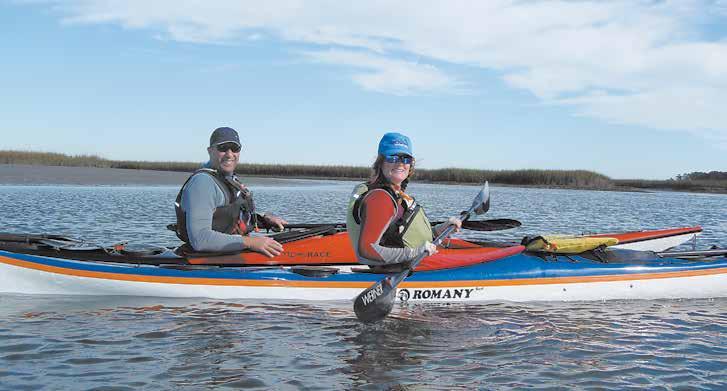
Maj. Inman and his wife Teresa at Mount Rainier.

hospital emergency medical care. He enlisted in the United States Army Reserve in 1987 as an infantry medic. Two years later, then-Spc. Inman switched to the Minnesota National Guard to become a flight medic. In 1990, Maj. Inman volunteered to deploy as an active duty medic for Desert ShieldDesert Storm. Assigned to the 101st Airborne Division, then-Pfc. Inman (as the active duty component did not recognize National Guard rank, NG Sgt. Inman became active component PFC Inman) deployed to Saudi Arabia early on during the conflict. Serving as a flight medic, Pfc. Inman participated in the largest air assault mission in the history of the United States Army: Blackhawks flying 65 miles behind enemy lines to set up a forward operating base (FOB) and setting an entire battalion on the ground in a single twenty-four hour period.
Back at Ft. Campbell, Kentucky in February 1993, an unexpectedly severe snow storm hit the Great Smoky Mountains. In a 24- hour period, ten feet of snow accumulated in an area unused to getting more than a dusting of snow. As a result, many people— including 180 high school students from Michigan on a winter backpacking trip—were stranded in dire circumstances. Sgt. Inman’s unit mobilized for search and rescue, eventually rescuing 104 stranded hikers and two dogs using helicopters and rescue hoists.
By 1994, Maj. Inman had left active duty and returned to the Minnesota National Guard, finishing his four-year college degree in Social Philosophy at Metropolitan State University in St. Paul, Minnesota. He then attended and graduated William Mitchell College of Law with his juris doctorate
Maj. Inman receives the Bronze Star. Camp Victory, Iraq.
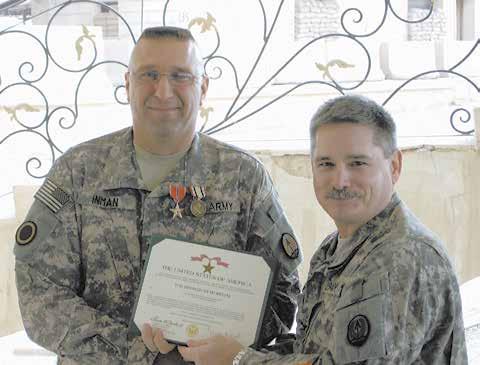
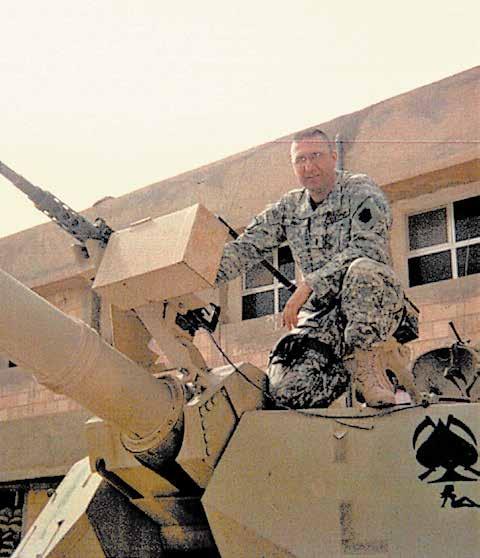
Maj. Inman swearing into the MNNG with MN TAG.
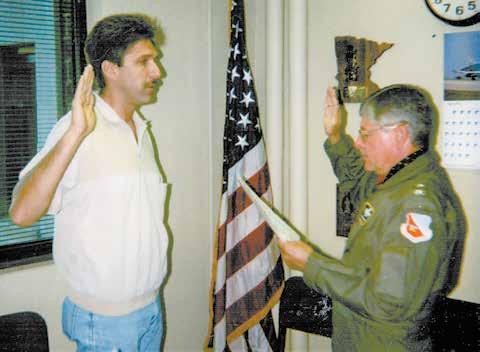
(law) degree in 2000.
During these years, Maj. Inman tried to avoid his destiny by leaving military service in 1996. However, one day after he entered his lawyering years as a prosecutor, then-Mr. Inman went to a Lions Club lunch where the speaker was the two-star Minnesota Adjutant General (TAG). The general remembered flying with the former Sgt. Inman and commented “What are you doing out in Minnesota in a suit?” Whatever then-Mr. Inman answered, the general turned to his major aide-de-camp and said “Get this man in my Army.” It obviously did not take much to bring Maj. Inman back into military service: in June 2001, Maj. Inman re-enlisted in the Minnesota National Guard. After four years as an enlisted lawyer, then-Staff Sgt. Inman commissioned as a first lieutenant in the United States Army Reserve Judge Advocate General’s Corps (JAG).
In 2005, then-Cpt. Inman found himself far from his Minnesota roots in Ramadi, Iraq. In his first deployment as a JAG, Maj. Inman served as the Trial Counsel (prosecutor) with the Pennsylvania National Guard 28th Infantry Division. In 2009-2010, then-Cpt. Inman returned to Iraq, serving as an Operations Law Attorney for Multi-National Corps-Iraq (MNC-I). In this position, then-Cpt. Inman was the driving force on the Forensics Joint Planning Team, directly contributing to a plan that enhanced the Iraqi forensics capacity throughout the country- -demonstrating the flexibility, resiliency and broad-based skills of JAGs Army-wide.
In between deployments, Maj. Inman was assigned at Ft. Lewis I Corps Office of the Staff Judge Advocate (OSJA) from 2006- 2012. During that time, he served as a Special Assistant U.S. Attorney for Western District Court of Washington (SAUSA) and Acting Chief of the I-Corps OSJA Federal Litigation Division.
Maj. Inman assessed to the U.S. Army Reserve, Active Guard Reserve (AGR) in July 2012. As an AGR, Maj. Inman’s first assignment was with USARC Office of the Staff Judge Advocate as a Military Justice Judge Advocate. He was then assigned to the 412th Theater Engineer Command in Vicksburg, Mississippi, as the Deputy Staff Judge Advocate. And, finally, he was assigned to the 104th Division (Leader Training) at Joint Base
Maj. Inman in Ramadi, Iraq 2005-06.
Lewis-McChord as the Maj. Inman immediately says, “I didn’t know anything about a training division when I was assigned.” But he quickly learned to appreciate and admire the history of the 104th and what the division stands for, it’s Pacific Northwest lineage making it more interesting. Anyone who asks Maj. Inman will be educated about the 104th Nightfighters—who, in the last months of the World War II, fought the Germans under cover of nightfall using empty rifles, bayonets and grenades with successful outcomes.
Maj. Inman is married to Teresa, a retail buyer for state and national park gift shops. He has two adult sons and an adult step-daughter, with six grandchildren and one great-grandchild. With 28 years of service behind him, Maj. Inman says that the first thing he plans to do is “unpack”. He is looking forward to fully moving into their home in Sequim, Washington and spending more time following his passions: kayaking and hiking. He will continue as a kayak leader and instructor with the Olympia Mountaineers.
Soldier first, lawyer always! And a great public servant!
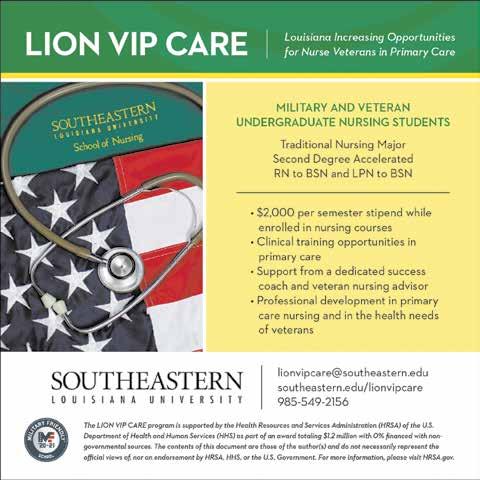
Leaders of the Pack: 104th Training Division (LT) 2020 Best Warrior Competition winners
Story and Photos By Sgt. 1st Class Darleen Adkins
PAO NCO, 104th Division (LT)
The 104th Division (LT) Best Warrior Competition (BWC) took place this year at Fort Knox, KY from March 5-7. The following competitors won the title of Soldier of the Year (SOY), NCO of the Year (NSOY) or Drill Sergeant of the Year (DSOY) for their respective brigades:
Spc. Joseph Dempsey
with Bravo Company, 2nd Battalion, 319th Regiment (Cadet Summer Training) was named 1st Brigade’s SOY. He is from Roanoke, Virginia, and currently serves in the Salem, Virginia, unit as a trainer. He enlisted in 2016 “…because I wanted to fight Isis…I was reading an article about their slave camps for adolescent kids. That’s all it took to get me to join.” Dempsey is also air assault qualified and previously served in the 1-32 Cavalry, 1st Brigade Combat Team, 101st Airborne Division. He is currently pursuing a degree in Criminal Justice and would like to serve in law enforcement after graduation.
Spc. Kevin Caladie with Alpha Company, 3rd Battalion, 304th Regiment (USMA), was named SOY for 2nd Brigade. He is from New Brunswick, New Jersey and currently serves in the Saco, Maine, unit training West Point cadets on the AT-4. He joined the military because of family members who have served,

Drill Sergeant of the Year
(Center) 1-398th Command Sgt. Maj. Renfrow (left) and DS Osborne (right) surrounded by other 1-398th competitors DS McDowell, Sgt. Sack on the left and DS Webb and DS Masterson on the right.

“Service to country is a staple in the Caladie family. My ‘Pop-pop’ and great uncle were Vietnam veterans with the USMC.” When asked what his advice would be to Soldiers who are considering next year’s BWC, Caladie stated “never quit”. Spc. Caladie has completed Basic Leader Course, and is currently studying Business Management with a long term goal of a degree in real
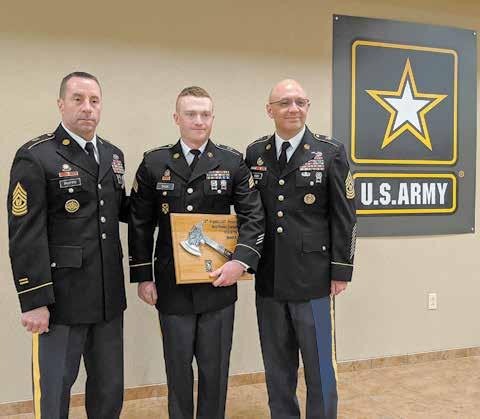
Spc. Joseph Dempsey
estate law.
Sgt. Jarrick Rehn with Alpha Company, 3rd Battlion, 414 Regiment (Cadet Summer

Training) was named 1st Brigade’s NSOY. He is from Tacoma, Washington, and currently serves on Joint Base

Spc. Kevin Caladie
Lewis-McChord as a trainer. He enlisted in 2009 for pure love of country. “I’ve always wanted to serve” he stated. He started his

military career at Alpha Company, 2nd Battalion, 7th Calvary, 4th
PACK Cont’d on page 38

Pack Cont’d from page 37 Brigade Combat Team, 1st Cavalry Division, Fort Hood, Texas. An Infantryman, he deployed to Iraq as an automatic rifleman and grenadier for two campaigns; Operation Iraqi Freedom and Operation New Dawn achieving many decorations and awards throughout his career. Before arriving at the 3-414th REGT (CST), he also served as a rifle team leader in the 1st Battalion, 27th Infantry Regiment, 2nd Brigade Combat Team, 25th Infantry Division in Hawaii and as a grenadier in the 2nd Battalion, 506th Infantry Regiment, 4th Brigade Combat Team, 101st Airborne Division (Air Assault) at Fort Campbell, KY. When asked what kept him resilient during the challenging times in the competition, Rehn replied, “Just knowing I had to win. I grew up being very competitive and couldn’t quit at anything and always had to try.” In his free time, Rehn enjoys rock climbing, bouldering, running and taking his family and dogs to the park.
Sgt. Rickey Sack Jr., with Headquarters, 1st Battalion, 398th Regiment (BCT) was named 2ND Brigade NSOY. He is from Lynnville, Indiana, and currently serves in the Owensboro, Kentucky unit as a S3 Operations Sgt. Sack enlisted in 2008, has completed Basic and Advanced Leader courses, and deployed during Operation Enduring Freedom in 2011- 12, receiving a number of awards that included the Army Commendation Medal. When asked what competing in the BWC means to him he stated, “It enables me to push myself and to use the knowledge that I have gained throughout my military service as well as learning things I have yet to learn in my time I
Soldier of the Year
From right to left, 1st Brigade Command Sgt. Maj. Todd Kaim, 104th Division (LT) Command Sgt. Maj. William Phipps,Spc. Dempsey and Spc. Caladie.

have been in the military.” In his free time, he enjoys hunting and camping, exercising and studying. Sack is also a volunteer firefighter and is pursuing a Bachelor’s degree to become a mental health counselor.
Staff Sgt. Derrick Osborne
with Charlie Company, 1st Battalion, 398th Regiment (BCT) was named 2nd Brigade DSOY. He is from Calhoun, Kentucky, and currently serves in the Evansville, Indiana, unit as the Senior Drill Sergeant responsible for the training and successful development of drill sergeant
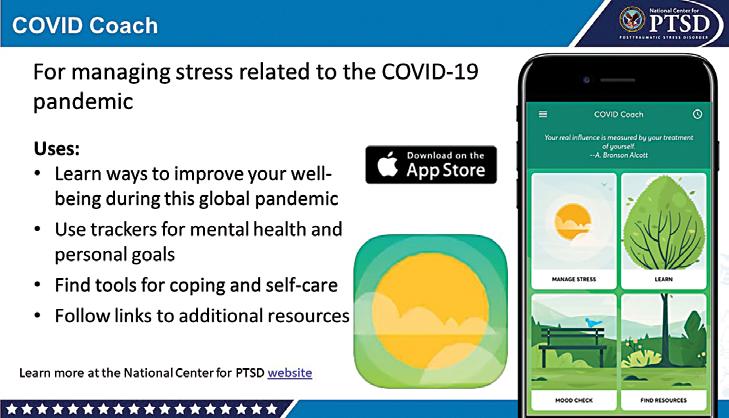
— Staff Sgt. Derrick Osborne
candidates. Drill Sergeant Osborne has completed numerous professional military schools, is instructor and Cavalry Scout qualified, and has served in this role the past six years of his eleven years in the military. He credits his wife who also serves for his reason for joining the service and counts his Command Sgt. Maj. CSM Renfrow along with his wife as mentors stating “Without them I would not be where I am at and the NCO I strive to be.” He also considers the NCO creed as an important, early resource, “I learned [it] and lived it during my career so far, it’s been a guiding light when darkness was present.” Although he admits long competition days and nights wore him down, he utilized the camaraderie and support from other Soldiers from his battalion who were also there competing to stay motivated. When asked what he would advise Soldiers who are considering the competition, he stated “Care about what you’re doing. Strive to be who you want your Soldiers to be.”
The winners will now go on to compete in the 108th Training Command BWC during the summer.
UC Berkeley Dean Appoints SROTC Instructors to Assistant Adjunct Professor
By Maj. Daniel D. Morse
Assistant Professor of Military Science, University of California, Berkeley 4th Battalion, 414th Regiment (SROTC), 1st Brigade, 104th Division (LT)
Maj. Dan Morse, Maj. Jennifer Nam, and Maj. Ben Raphael were appointed to the position of Assistant Adjunct Professor by the University of California at Berkeley after completing several evaluation board requirements this academic year. These officers serve in the 4-414th Senior Reserve Officer Training Corps (SROTC), a unit that supports university ROTC programs with Reserve instructors to supplement the school’s active duty cadre. The 4-414th (SROTC) assigned them to Berkeley as Assistant Professors of Military Science; however, Berkeley is unique in that it does not recognize SROTC instructors until they have been boarded by the Military Officers’ Education Committee (MOEC).
The MOEC was established in the 1970’s as the chancellor’s advisory committee ensuring the academic quality of the Military Affairs program and the three SROTC departments (Army, Navy, Air Force) that comprise it. The primary function of the committee is to evaluate the military officers appointed as SROTC professors in a manner similar to the other Berkeley academic departments. This requirement sets Berkeley apart from practically all other colleges and universities that
4-414th SROTC Assistant Professor of Military Science MAJ Dan Morse with his UC Berkeley students from the Military Science 202: Army Doctrine and Decision-Making course.

host SROTC programs.
Majors Morse, Nam, and Raphael each completed the MOEC board file review of their resumes, service record briefs, evaluation reports, letters of recommendation, personal statements, and transcripts showing master’s degree completion. The review culminated with interviews from the MOEC designed to determine the appropriate level of appointment within the adjunct educator ranks (lecturer, assistant professor, or professor). This academic appointment accompanies these professors’ listing of record in the Berkeley course catalog and will be reviewed annually by the MOEC.
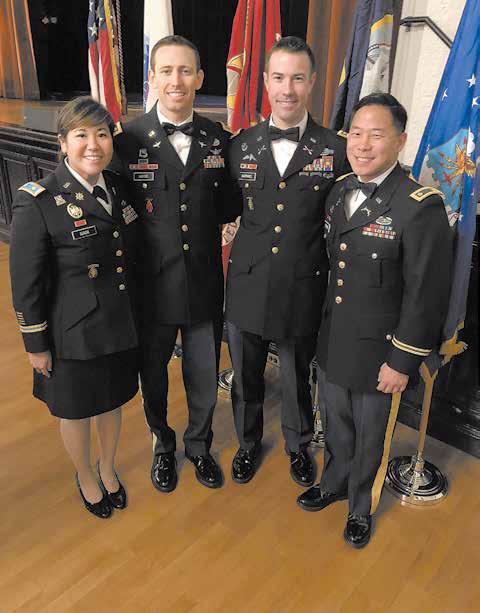
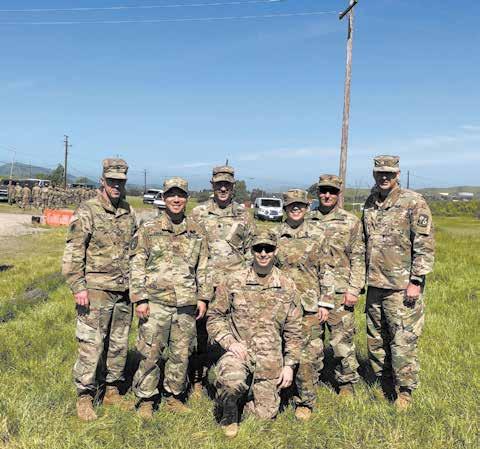
By Maj. Edward Howard, S6
2-319th CST Battalion and
Pfc. Cloyse Eldridge
USARC, Salem, Virginia
The Officers of the 2nd Battalion, 319th Regiment (Cadet Summer Training), 1ST Brigade and its subordinate companies conducted a staff ride at Appomattox Courthouse National Historical Park during their March Battle Assembly. This historically significant park is ideally located for this activity, roughly between the three geographic locations of the battalion and its subordinate companies.
Appomattox Courthouse, Virginia w as the location of the final confrontation between The Army of Northern Virginia and Union Forces. It was the second meeting on the battlefield between Robert E. Lee and Ulysses S. Grant, ultimately the surrender of the Army of Northern Virginia, and the beginning of the end of the US Civil War. The subjects of the staff ride were the battles that occurred at the location and the ensuing surrender of the Army of Northern Virginia.
The following is a brief summary of key events leading up to and influencing the surrender.
Earlier in the Civil War, President Lincoln had selected Grant to lead the Union Army. Lincoln and Grant agreed that in order to defeat the Confederacy it would not be sufficient to capture civilian governances in order to win the war and keep the Union intact. Rather, The Confederate Armies must be defeated. Based on this, Union forces pursued Confederate forces relentlessly and attacked confederate forces and their supply trains.
In the months and weeks leading up to the showdown at Appomattox, Grant began to enact his plan to close with and destroy the Confederate forces. The saga began with the Siege of Petersburg
Officers of 2-319th CST BN (LTC Jack Rebolledo, CDR, Top Center) pose in front of the Clover Hill Tavern
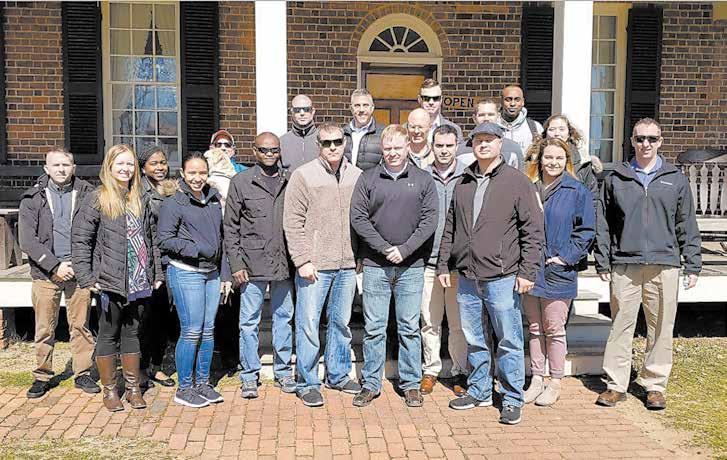
and lasted 9 months ending April 2, 1965 when Lieutenant General Ulysses S. Grant’s Army was able to cut Lee’s supply line into Petersburg at the battle of Five Forks. This forced the Army of Northern Virginia westward from Petersburg and then Richmond. Lee had planned to meet up with a supply train at Amelia’s Courthouse (West of Richmond) and thereafter the Army of Tennessee in an effort to continue the fight.
However, General Grant’s forces pursued Lee’s Army as it moved westward and continued the assault. Several Battles occurred leading up to the Battle of Appomattox Courthouse and the ensuing surrender. Among these were the Battles of Sailor’s creek, High Bridge, Farmville and Cumberland Church.
The Battle of Appomattox Station, April 8th, 1865: The 2nd New York Cavalry, subordinate to

Appomattox Courthouse, Appomattox Courthouse National Historical Park, Appomattox, VA
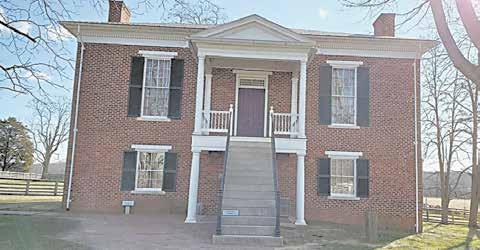
notable Civil War Commanders Brevet Maj. Gen. George A. Custer and Maj. Gen. Philip A. Sheridan, attacked a Confederate Supply point at Appomattox Station. The supply point had several trains with supplies to include artillery and food rations. Confederate General Brig. Gen. Reuben Lindsay Walker’s Reserve Artillery attempted to defend the supply point with artillery fire, but the effort was unsuccessful and the supply depot was ultimately captured by Union Forces which blocked the road, cutting off Lee’s retreat westward.
The Battle of Appomattox Courthouse, April 9th, 1865: The final battle of the day happened on the morning of April 9th near the Appomattox Courthouse. The confederate Army made slow progress moving forward against the 2nd NY Cavalry, which was equipped with repeating rifles. Later that morning two Divisions of Infantry arrived to support the Cavalry. The Army of Northern
Virginia was thus trapped, exhausted, and without supplies. Having communicated with General Grant over the prior few days regarding possible surrender terms, around 11 a.m. the Army of Northern Virginia waved a flag of truce.
The Surrender, April 9th, 1965:
Lee had previously sent a letter to Grant asking Grant what his terms of surrender might be. Grant responded he would meet at a place of Lee’s choosing to discuss the full terms of surrender. Around 11 a.m. the Army of Northern Virginia waved a flag of truce, ending the Battle of Appomattox Courthouse. The place chosen for the meeting was a parlor of a house owned by Wilmer McLean, located just west of the actual Appomattox Courthouse.
General Lee arrived first, at 1 p.m. dressed in a fresh clean uniform, polished boots, and a polished sword, and took a seat in the room. General Grant was advised en route to the battlefield that Lee was waiting for him at the parlor. Mounted and wearing a muddy uniform, he hastened to meet
General Lee for the second time in their lives, and arrived at about 1:30 p.m. As noted by the Park Service tour guide, the first time they had met was during the Mexican War. Lee had been a Senior Officer in the war and Grant a Junior Officer serving as a Regimental Quartermaster. Grant had arrived to a briefing of senior Officers in a dirty field uniform, and Lee chastised him for this.
Small talk finally led to a discussion of terms, wherein Lee asked Grant to write out his terms. Two crucial aspects of the written terms were a requirement for a formal surrender wherein Confederate Soldiers would lay down their arms, and following this the Soldiers would be given parole papers and be allowed to return home. Per Grant’s direction, these parole papers guaranteed the Confederate Soldiers safe passage from Union forces on the way home, and could be used at Union supply stations to secure food or transit on Union military trains and

ships.
At Lee’s request, Grant also agreed to two other unwritten requests. These were that the Confederate Soldiers would be provided immediate rations, and the Soldiers could keep privately owned livestock for their return to farming.
The surrender occurred over three days, with all Confederate Soldiers laying down their arms in front of Union troops. The Cavalry surrendered their arms first, so that the men could depart with their horses because there was very little forage remaining in the area.
It should be noted that Confederate President Jefferson Davis had given Lee orders, should he be unable to prevail over the Union Army, to disband the Army of Northern Virginia and direct the Soldiers to pursue guerilla warfare against the Union. General Lee chose instead to surrender the Army of Northern Virginia based on the favorable terms offered by General Grant, though he declined Grant’s request that he issue a surrender order to other Confederate Armies.
This decision to surrender his Army and also the terms of surrender marked one of the most significant turning points in US History. First, it sent a message that the Confederacy could not win the war. Second, and more importantly, the terms of this “Gentlemen’s Agreement” is considered the first mending of the rift between the Northern and Southern states.
The Battalion Commander, LTC Jack Rebolledo, took advantage of this opportunity to conduct an Officer Professional Development briefing on Officer Professional Military Education and the Officer promotion process for the four Field Grade and ten Company Grade Officers present. Said the
Map of Central and Eastern Virginia with locations of the 2-319th CST BN Headquarters and Subordinate Companies. From Google Maps
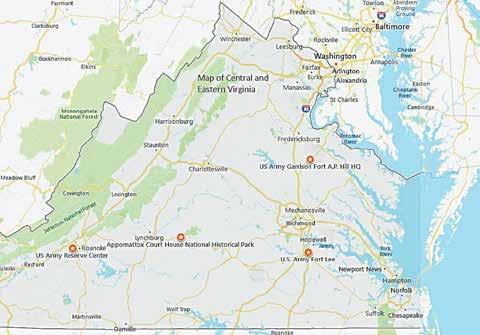
Battalion Commander: “This was a terrific coming together of all of the Officers in the Battalion. We were extremely fortunate to have such pleasant weather today. I have to commend the S3 for his thorough planning and thank the Park Service Staff for an informative and interesting briefing. I appreciate all of the Officers for making the effort to come together for this event.”
Citations: 1. National Park Service Staff 2. https://www.historynet.com/ appomattox-court-house-battle 3. https://www.nps.gov/apco/ final-battles.htm 4. https://en.wikipedia.org/ wiki/Appomattox_campaign_
Union_order_of_battle











